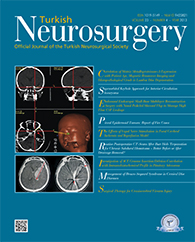Case Description: All three patients in this series presented with elevation of free skull fracture fragments above the surface. The mode of injury was rail accident in two patients and injury by a rapidly moving crane in one patient. Two patients had dural laceration with extrusion of brain matter through the dural defect. The remaining patient had an elevated fracture fragment simulating a formal craniotomy with an intact dura. The patient who suffered crane injury was brought dead. Surgery was performed in remaining two patients. Wound debridement and duraplasty was performed. Both patients received broad-spectrum antibiotics in anti-meningitic doses. Both of these patients did well after surgery.
Conclusion: Elevated skull fractures are usually compound injuries. High velocity tangential impact to the skull vault is the most likely causative mechanism in such type of injury. Delay in surgery could lead to intracranial sepsis including meningitis and brain abscess. Thus, these fractures should be aggressively treated.
Keywords : Skull fracture, Compound, Elevated




